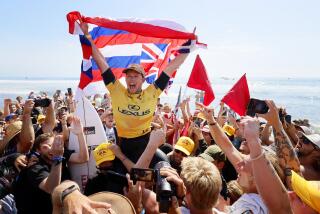Pipeline’s Ready for Its Close-Up Again
- Share via
The rules of engagement, handwritten on a page of an elementary school math book, were spelled out clearly enough:
“Due to the explosive nature of this dangerous break in shallow water only 75 yards off the beach, the win will go to the surfer who can ride the deepest in the tube for the longest period of time, reappear and then complete the wave without falling off his surfboard.”
And so the brainchild of Fred Hemmings, the Hawaiian Masters, became a reality on Dec. 16, 1971, at the now-fabled Banzai Pipeline on Oahu’s North Shore. Six surfers were invited to participate and Jeff Hackman won, claiming the top prize of $500.
Today, the competition window opens for what is now called the Rip Curl Pro Pipeline Masters, widely perceived as the Super Bowl of surf contests. The 45 surfers on the elite World Championship Tour, plus two wildcard entries, will vie for $270,000, with $30,000 going to the winner.
“As an event, the Masters is in its own orbit,” said Wayne “Rabbit” Bartholomew, president of the Assn. of Surfing Professionals, which governs the tour. “Nowhere on Earth can spectators experience such an up-close viewing of Mother Nature’s intimate interaction with the raw elements.”
The rules have changed considerably.
Athletes now must advance through elimination heats to get to the final, and post the sum of their two best wave scores per heat against those of their rivals; the most points in a heat determines the winner.
But 34 years after its inception, the basic premise remains: Catch the biggest wave you can, survive the near-sheer drop, crank a bottom turn, tuck under the cascading lip and stay in the tube as long as the wave will allow.
And by all means, hold your balance, because the explosive nature of this break can be devastating. That danger became all too real last week when Malik Joyeux, who had hoped to compete in the Pipeline Masters, died after failing to duck under. His board snapped in two. His leash was torn off and his body remained underwater for more than 10 minutes before it was discovered more than 200 yards away. The reality of his death, on the eve of the contest, will not be lost on the competitors.
But nor will it make them timid; they have surfed Pipeline enough to become keenly aware of its power. All have endured nasty wipeouts, from the legendary Gerry Lopez, who reigned in the early years, to defending champion Jamie O’Brien.
“If you win a contest out at Pipe, you’re just the master of a few waves that day,” said O’Brien, 22, who lives on the beach in front of the break. “Once you think you’ve mastered the wave, that’s when you get hurt.”
From O’Brien’s house, it’s difficult to sleep when a big swell arrives in the night, because the booming sound is like that of crackling thunder, but with an earth-shaking effect.
The Pipeline Masters, the last event on the ASP calendar and third leg of the Vans Triple Crown of Surfing, is steeped in lore.
Lopez, who missed the first contest after being duped by rival Corky Carroll into thinking it had been canceled, won the next two years with a stylish calm so impressive that, legend has it, ABC’s Jim McKay wiped tears from his eyes while on the air.
In 1995, Kelly Slater came from behind to win his third Pipeline Masters and his third world title by going right instead of left on a seeming closeout and emerging from the tube nearly 10 seconds later, amid screams and cheers from the beach. He did the same thing on his next wave -- both were scored perfect 10s.
Last year, O’Brien, who is not part of the World Championship Tour, stunned the surfing world by outperforming the WCT athletes and winning as a wildcard.
“People are continuing to congratulate me all over the world,” he said. “You would think people have forgotten about it by now.”
Perhaps they will when a new winner emerges.
More to Read
Go beyond the scoreboard
Get the latest on L.A.'s teams in the daily Sports Report newsletter.
You may occasionally receive promotional content from the Los Angeles Times.










